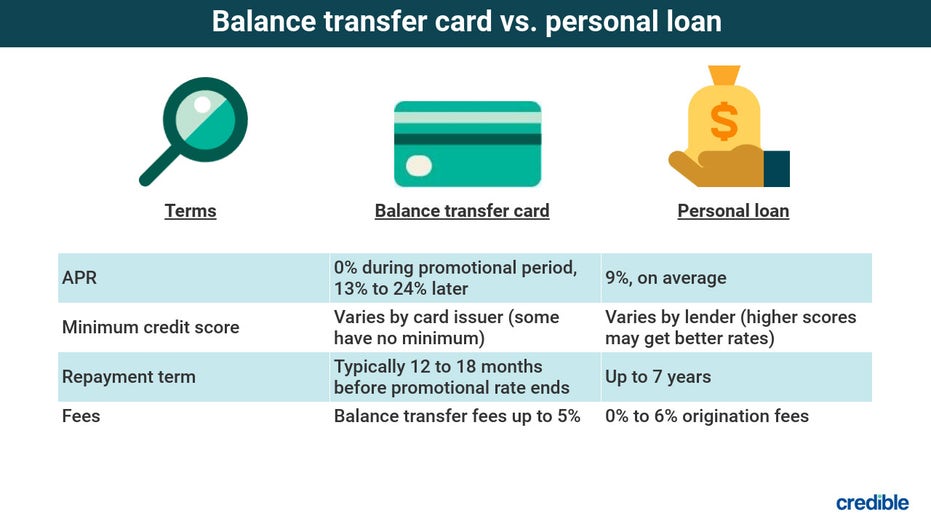Debt consolidation vs. credit card refinancing: What's the difference?
If you’re unsure how to best tackle your credit card debt, this guide to debt consolidation vs. credit card refinancing can help. (iStock) If your credit card balances get difficult to manage, paying off those debts with a personal loan may be an option. Sometimes, this is referred to as debt consolidation. Others may call it credit card refinancing. In both cases, it means rolling your card balances into a personal loan, which you’ll then pay off monthly over time. Here’s what you need to know about debt consolidation vs. credit card refinancing. If you’re considering rolling credit card debt into a lower-interest personal loan, Credible makes it easy to compare personal loan rates from multiple lenders. Credit card refinancing is when you use another financial product — often a personal loan — to pay off your credit card balances. You then make monthly payments on that loan until it’s repaid in full. This process may allow you to get a lower interest rate (credit cards have very high rates compared to most personal loans), and it also streamlines repayment, so you make just one single payment per month rather than several. Credit card refinancing is typically best for borrowers who have decent credit and can qualify for personal loans with a lower interest rate than their credit cards. Banks, credit unions, and online lenders typically offer personal loans that you can use to refinance your credit card debt. This requires a credit check and various forms of financial documentation. The lender you choose will depend on multiple factors, including your credit score and how quickly you need the loan funded. For example, some online lenders can fund a loan as quickly as the next business day after approving the loan. It’s a good idea to compare personal loan rates from multiple lenders before deciding on a credit card refinancing loan. Credible makes it easy to see your prequalified rates in minutes. Like any financial product, a debt consolidation loan has advantages and disadvantages to consider. Credit card refinancing and debt consolidation are one and the same. In both scenarios, you’re using a personal loan or other type of loan product to pay off credit cards and other debts you may have. This essentially replaces your debts with a single loan, which you can then pay off over time. Refinancing your credit cards and using a balance transfer card have the same general principle, but the two can have very different results. With a refinance, you end up with a single, fixed-rate payment for the long haul. It streamlines the repayment of your many debts, and it often results in lower interest costs, too. With a balance transfer card, you use a new credit card to pay off another card (or several). These cards come with a low introductory rate — often even 0%, which expires after 12 to 18 months. At that point, the rate goes up significantly. While balance transfer cards can save you interest if you pay off the balance before your introductory period ends, if you can’t repay the balance on your new card by that point, it may mean significantly more interest costs in the long run. The right choice depends on your balances, interest rate, credit score, and other factors. Generally speaking, a balance transfer may be a good idea if: But in other situations, a personal loan makes more sense, especially if: Here’s an example: Say you have $10,000 in credit card debt, and your bank is offering you a balance transfer card with a 0% interest rate for 18 months. Under these terms, you’d need to pay at least $555 every month in order to pay off the balance before your introductory rate expires. If this isn’t feasible, a personal loan may be a better option, offering you a longer payoff timeline and lower monthly payments. Credit card refinancing with a personal loan is typically best when: Credit card balance transfers are typically best when: You don’t need a perfect credit score for a debt consolidation loan, but the higher your score is, the more likely you’ll be able to qualify for a personal loan for the amount you need and at a favorable rate. Generally, it takes a score of at least 650 to qualify, and a score of 720 can make it more likely that you’ll qualify you for the best available APR. If you’re below these thresholds, you can try a debt consolidation loan for bad credit borrowers or work on improving your score before applying. When you’re ready to proceed with your loan application or balance transfer credit card, make sure you shop around. Rates, fees, terms, and eligibility requirements vary by provider, so comparing at least a few different lenders and credit card companies can ensure you get the best deal. Credible makes it easy to see your prequalified personal loan rates in minutes, without affecting your credit. Source: Read Full Article
What is credit card refinancing?
Where to get a credit card refinancing loan
Pros and cons of credit card refinancing
Pros of credit card refinancing
Cons of credit card refinancing
Debt consolidation vs. credit card refinancing: Are they different?
Credit card refinancing vs. balance transfer cards

How to choose between credit card refinancing and balance transfer cards
What credit score do you need to take out a debt consolidation loan?